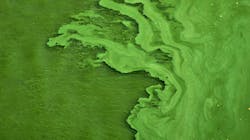
DAEJEON, KOREA — A new technology for analyzing water quality with drones and using artificial intelligence has been developed by the Electronics Telecommunications Research Institute (ETRI). The technology can be used to predict algal blooms, improving the management of drinking water.
Using a hyperspectral camera built into a drone, ETRI was able to measure and predict algal blooms in a remote lake. The research was published in the journal Remote Sensing of Environment (RSE) in January 2020.
Algae blooms can impact water quality, contaminate drinking water, create anoxic conditions in surface water, and negatively affect wildlife. The ability to monitor and predict algal activity is critical. Typically, monitoring involved collecting water samples during a site visit and then analyzing the samples—a process that often takes several days. Drones, on the other hand, can easily monitor water bodies, and at a lower cost than satellites, while still gathering high-resolution data.
ETRI's technology makes it easier and faster to study blue-green algae. Hyperspectral cameras on drones can remotely monitor water bodies and track migration and spread in rivers and streams. Conventional imaging divides light into three primary colors—red, green, and blue or RGB. Hyperspectral imaging can divide light, both visible and near-infrared, into over 200 or more colors, allowing imaged objects to be classified in more detail. In this case, the data gathered by the drone and the hyperspectral camera was then analyzed using an AI in order to better predict where blue-green algae will bloom. The ETRI hyperspectral camera analyzes the light spectrum of blue-green algae to gather data on the spread and severity of algae within a body of water.
For the study published in RSE, the ETRI team examined the water quality of the Daechung Reservoir in South Korea. Next, the team plans to construct a map to monitor algae blooms in the reservoir in real-time and explore automating the process of data collection, input, and analysis. The team hopes to improve the accuracy of their predictions and to reduce the weight and size of the hyperspectral sensor.
Earlier detection and accurate prediction of algal blooms and their dissemination could assist communities to respond earlier in order to reduce the severity and prevent the further spread of harmful blooms.
Source: ACN Newswire





